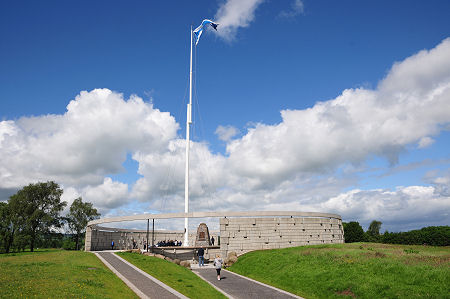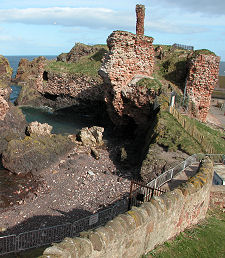 The Rotunda at the Battle of Bannockburn Visitor Centre |
King Edward II of England lived from 25 April 1284 to, probably, 21 September 1327 and was King of England from 7 July 1307 until his abdication on 24 January 1327. He is remembered by history as being far weaker and less effective than his father Edward I, and his son, Edward III. The wider picture in Scotland at the time is set out in our Historical Timeline.
Edward II of England, also known as Edward of Caernarfon, was a son of Edward I of England and his first wife Eleanor of Castile. He became heir to the throne at the age of four months when his eleven year old brother Alphonso, Earl of Chester, died on 19 August 1284. Edward II was born in Caernarfon Castle, one of the castles built by his father after suppressing the Welsh, and later became the first English prince to be known as the Prince of Wales. It is said when the Welsh expressed a preference for a prince who could speak Welsh, Edward I responded that his son would not be an English speaker, which was not much of a concession as the Plantaganets' native tongue was Norman French.
As a young man, Prince Edward took part in a number of his father's military campaigns in Scotland, and grew to be as physically powerful and imposing as his father. He was still a disappointment to Edward I, however, preferring what would in later centuries have been described as a playboy lifestyle. A particular issue revolved around Prince Edward's very close friendship with Piers Gaveston, a Gascon knight, on whom the young Edward bestowed favours and honours. Gaveston was exiled by Edward I in 1298 because of his influence on Prince Edward.
Edward I died on 7 July 1307 while en route to launch another military campaign against Scotland. Edward II did not carry through his father's wish that he press home the campaign, instead returning to London and recalling Piers Gaveston from exile and making him Duke of Cornwall. On 25 January 1308, Edward married Isabella of France, the daughter of King Philip IV of France, in an effort to form an alliance with France. They had two sons and two daughters together, but the marriage was not a happy one, with Edward more interested in his male friends and Piers Gaveston in particular. Discontent with Edward II's rule came to a head when Barons rebelled in 1312, murdering the, in their eyes, excessively influential Piers Gaveston before the revolt fizzled out.
A combination of an unusually weak English king and an unusually strong Scottish king, in Robert the Bruce, meant that English military power in Scotland waned throughout the early years of Edward II's reign. By November 1313, the English controlled only one stronghold in Scotland, Stirling Castle, and this was under siege by the Scots under Edward Bruce. Edward made a deal with the English Constable of the castle that if an English army had not arrived to relieve the castle by 24 June 1314, the castle would surrender, so making an aggressive siege unnecessary.
Edward II hastened to assemble an army of some 20,000: probably the largest English army (of many) to invade Scotland. They gathered in Berwick on 10 June 1314 and headed north. Late in the afternoon of Sunday 23 June the vanguard of the English army arrived at the ford over the Bannock Burn, a couple of miles south of Stirling. On the far side a Scottish army of some 7,000 awaited them. The main Battle of Bannockburn took place the following day, on 24 June 1314, and though at times it was finely balanced it turned into the greatest victory ever achieved over the English by a Scottish army. Edward II only just escaped after the battle: most of the English knights did not. Edward sheltered for a while at Dunbar Castle before fleeing south to face a deeply unhappy England.
After Gaveston's death, Edward acquired another male favourite, Hugh Despenser the Younger. By the early 1320s Edward was very unpopular with the population of much of the country for his all round ineffectiveness; with the English establishment for his willingness to bend and break the law to benefit his cronies; with France for failing to pay homage for Gascony; and with his wife for his neglect and preference for male company.
Another baron's revolt came to nothing. The Queen departed for France in March 1325, and in September 1326 returned with her lover, Roger Mortimer, 1st Earl of March and a small invasion force. Edward quickly found himself without support and Hugh Despenser the Younger was brutally executed on 24 November 1326. Edward himself was imprisoned at Kenilworth Castle and on 24 January 1327 was forced to abdicate in favour of his 14 year old son, Edward III, who was controlled by Isabella and Mortimer.
In April 1327 Edward II was moved to Berkeley Castle in Gloucestershire, and it is highly likely he was murdered here on the orders of Isabella and Mortimer on 11 October 1327. An account written a century later suggests this was done in a particularly unpleasant way intended to leave no external marks of violence on his body, but it is more likely he was suffocated. A funeral was subsequently held in Gloucester Cathedral. Some historians have suggested he died in exile in Italy in 1341: but as in 1330 Edward III executed Roger Mortimer on charges including the murder of Edward II, it seems that most people at the time believed Edward II was no longer alive.

